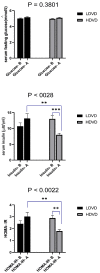A High Dose, Not Low Dose, of Vitamin D Ameliorates Insulin Resistance in Saudi Women
- PMID: 36362806
- PMCID: PMC9659018
- DOI: 10.3390/jcm11216577
A High Dose, Not Low Dose, of Vitamin D Ameliorates Insulin Resistance in Saudi Women
Abstract
Vitamin D has been traditionally seen to be mainly involved in the regulation of bone homeostasis. However, vitamin D has also been clinically linked to various diseases, including metabolic syndrome. The aim of this study was to examine the effect of low and high doses of a vitamin D supplement on the serum levels of 25(OH)D3 and insulin resistance. A total of 120 females were recruited in this study and supplemented weekly with 25,000 IU vitamin D or 50,000 IU vitamin D for three months. Anthropometric measurements were taken at the beginning of the study. Blood samples were collected at the beginning of the study to determine the baseline of the clinical variables and collected again after three months. Insulin resistance was measured using Homeostatic Model Assessment for Insulin Resistance (HOMA-IR). After vitamin D supplementation, a non-significant increase was observed in the serum levels of 25(OH)D3 in the group treated with a low dose of vitamin D (LDVD) and a highly significant increase was seen in the group treated with a high dose of vitamin D (HDVD). In the group treated with a higher dose (HDVD), a significant improvement in insulin sensitivity was observed. The high dose of vitamin D (50,000 IU) supplementation was more effective in both correcting the blood levels of vitamin D and improving the sensitivity of insulin.
Keywords: 25(OH)D3; body mass index; insulin; insulin resistance; type 2 diabetes; vitamin D deficiency.
Conflict of interest statement
All authors declare that they have no conflict of interest.
Figures





Similar articles
-
High-dose vitamin D3 supplementation in relapsing-remitting multiple sclerosis: a randomised clinical trial.EClinicalMedicine. 2023 Apr 13;59:101957. doi: 10.1016/j.eclinm.2023.101957. eCollection 2023 May. EClinicalMedicine. 2023. PMID: 37125397 Free PMC article.
-
Effect of high-dose vitamin D supplementation in combination with weight loss diet on glucose homeostasis, insulin resistance, and matrix metalloproteinases in obese subjects with vitamin D deficiency: a double-blind, placebo-controlled, randomized clinical trial.Appl Physiol Nutr Metab. 2020 Oct;45(10):1092-1098. doi: 10.1139/apnm-2018-0773. Epub 2019 Dec 24. Appl Physiol Nutr Metab. 2020. PMID: 31874050 Clinical Trial.
-
Vitamin D Supplementation Reduces Both Oxidative DNA Damage and Insulin Resistance in the Elderly with Metabolic Disorders.Int J Mol Sci. 2019 Jun 13;20(12):2891. doi: 10.3390/ijms20122891. Int J Mol Sci. 2019. PMID: 31200560 Free PMC article. Clinical Trial.
-
Vitamin D supplementation for sickle cell disease.Cochrane Database Syst Rev. 2020 May 28;5(5):CD010858. doi: 10.1002/14651858.CD010858.pub3. Cochrane Database Syst Rev. 2020. PMID: 32462740 Free PMC article.
-
Vitamin D and type 2 diabetes.J Steroid Biochem Mol Biol. 2017 Oct;173:280-285. doi: 10.1016/j.jsbmb.2016.11.021. Epub 2016 Dec 5. J Steroid Biochem Mol Biol. 2017. PMID: 27932304 Review.
Cited by
-
Evidence That Increasing Serum 25(OH)D Concentrations to 30 ng/mL in the Kingdom of Saudi Arabia and the United Arab Emirates Could Greatly Improve Health Outcomes.Biomedicines. 2023 Mar 23;11(4):994. doi: 10.3390/biomedicines11040994. Biomedicines. 2023. PMID: 37189612 Free PMC article. Review.
-
Vitamin D: Evidence-Based Health Benefits and Recommendations for Population Guidelines.Nutrients. 2025 Jan 14;17(2):277. doi: 10.3390/nu17020277. Nutrients. 2025. PMID: 39861407 Free PMC article. Review.
References
-
- Sizar O., Khare S., Goyal A., Givler A. Vitamin D Deficiency. StatPearls; Treaure Island, Finland: 2022. - PubMed
Grants and funding
LinkOut - more resources
Full Text Sources

